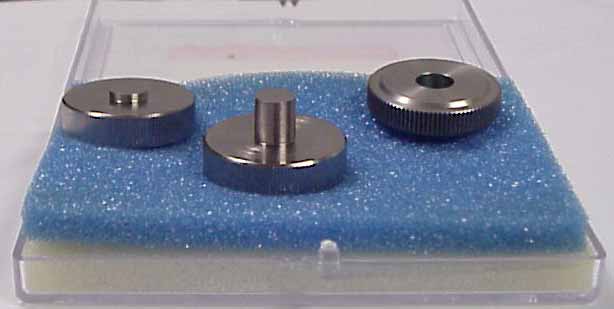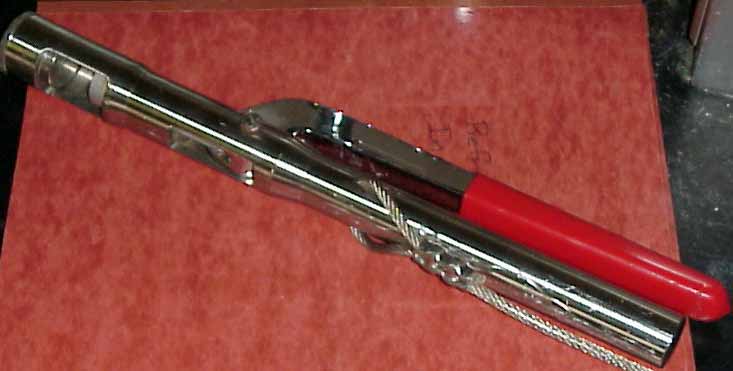Practical aspects of Infrared Spectroscopy or "How to get a good IR spectrum"
In order to be able to get any meaningful information out of your IR spectrum, you need to have a decent spectrum with sharp peaks, which have a 'good' intensity and good resolution. Ideally the largest peak, which is due to your compound should have an intensity of 2-5%T. Most detectors only response linear over a certain range (typically one magnitude). Keep in mind that a transmission of 5% is equivalent to an A=1.3, which is upper limit for most detectors. If you observe a higher intensity, all your impurities will seem to be more significant than they really are. The peaks with the high intensity will be ‘cut off’.Therefore it is very important to prepare the sample properly:
a. Liquids:
place a small drop of the compound on one of the the plates. Place the second plate on top and make a quarter turn to obtain a nice even film. If this proved to be too much already, separate the plates and wipe on side clean before you put them back together.
b. Solids (as solution):
If you need to get an IR spectrum for a solid, you will have to prepare a concentrated solution of your compound in a suitable solvent (e.g. CH2Cl2). There are several ways to do this depending how much material you have at hand: either you place a small amount (2-5 mg) of your compound directly on the plates and add one drop of solvent, or you dissolve it in a small test tube first and transfer this solution with a pipet onto the IR plates. Which technique is the better one, depends on the amount of the compound available. (Reminder: Obtain a spectrum of solvent as well)
c. Solids (as Nujol suspension or pellet)
Alternative methods to obtain IR spectra of solids are Nujol mulls (mineral oil) between AgCl, NaCl, KBr or CsI plates or KBr pellets. These compounds are ionic and usually do not have any peaks in the range that you will acquire your IR spectrum in.
In order to prepare a KBr pellet, follow the procedure given below:
Sample/KBr ratio
The concentration of the sample in KBr should be in the range of 0.2% to 1%. The pellet is much thicker than a liquid film, hence a lower concentration in the sample is required (Beer's Law). For the die set that you will be using, about 80 mg of the mixture are needed. Too high of a concentration causes usually difficulties to obtain clear pellets. The IR beam is absorbed completely, or scattered from the sample resulting to very noisy spectra.
Sample preparation
Although a homogeneous mixture will give the best results, an excessive grinding of the potassium bromide is not required. The finely powdered potassium bromide will absorb more humidity (=hygroscopic) from the air and therefore lead to an increased background in certain ranges.
Loading the die set
1.Test if the anvil with the long pin can freely move through the collar before you start loading the die set. If not, check for obstructions on teh inside of the collar.
2. Place the anvil with the shorter pin on the bench (left side).
3. Place the collar on top of it. Add a small amount of the KBr/sample-mixture, which covers the bottom pin in the collar.
4. Place the die with the longer pin (middle) on the top and turn the piece by 360 degrees to spread the sample out evenly. Remove the top anvil and check if the entire bottom pin is covered evenly. This is necessary to ensure that the pellet sticks to the walls of the collar afterwards.

Forming the pellet
1. Place the die set in the hand press. It is imperative that the die set is seated against the back wall. This will center the set. Warning: Pressing the die set off center will result in a bending of the head of the press. Further use of the press will bent the head even more and cause the top anvils to shear off.
2. Hold the hand press in upright position and load the press as described above. Close the handle slowly. If the handle of the hand press is too far in or out, adjust the distance of the ram by turning the dial on the top.
3. After adjusting the distance, close the handle slowly to apply pressure for 30 seconds, making sure that the open end points away from you and yoru fellow students. Then open the handle, making sure to hold on to the die set (so that it does not drop on the floor). Do not apply excessive force to form a pellet. This will break the die sets and the hand press.
4. Turn the die set around and remove the bottom anvil. If the pellet is clear, remove the top piece as well. If not, place the bottom anvil back in place, and press again with a slightly higher pressure.
5. To perform the measurement, place the collar only in the holder of the IR machine.
Clean-up
1. Make sure that you clean the mortar and pestle thoroughly.
2. The die sets have to be taken apart and cleaned as well. They corrode easily and will be worthless in a short period of time.
3. Dispose of the KBr/sample mixture in a solid waste container and not in the trash.
Warning
Follow the procedure given above and try to avoid to break the press or die set. A press currently runs for about $500-600 and the individual pieces of the die set for about $50-60. If something does not look right e.g. you obtain unevenly pressed pellets report it to the TA. S/he can check the press out and evaluate what the problem is.

above: KBr press
A nujol mull is obtained by grinding up the solid and mixing it with mineral oil to form a suspension, which placed in between AgCl, NaCl, KBr or CsI plates. (Reminder: Obtain a spectrum of mineral oil as well). The compound has to be well dispensed between the plates to order to obtain a good spectrum. Sometimes you need to play a little bit around to find a 'good' concentration, which allows you to observe all the peaks you expect (Hint: It might be a helpful to have an idea which peaks you can expect and chose the matrix appropriately). Especially dark compounds often cause problems, because the transmission is very low in general.
Independent from the technique that is used, you should obtain the IR spectra in the range from 600-4000 cm-1 (for organic compounds). Make sure that you check the background before you obtain the spectrum of your actual compound (What does the background show?).
d. General remarks
The new generation of IR spectrometer allows you to process data electronically and to improve the quality of a spectrum significantly
The laboratory course uses IR plates:made from AgCl. Keep in mind that these plates are very expensive (AgCl: ~$150) Make sure that your compound does not react with the IR plates (strong oxidizing or reducing reagents ?). If you check them out from the TA (in exchange for your ID card), it is your responsibility to return them in proper condition (clean and complete!). Clean them with dry acetone and Kim wipes, and not with water, alcohol ,and brown or white paper towels! (Why?) AgCl plates have to be stored a closed box, protected from light.
Prepare the IR samples at a work bench, and not at or on top of the IR instrument. We encountered problems in past, because students spilled chemicals inside the instrument, which caused 'wrong' spectra and serious damage to the instrument, which cost $$$.
The interpretation of the IR spectrum should include a detailed assignment of peaks with the exact wavenumber (integer number are sufficient, why?) from the spectrum, the intensity (weak/medium/strong) and to which functional group this peak belongs to, maybe in addition the corresponding literature value if available. Be cautious, if you compare spectra which were obtain with different techniques (solution, Nujol mull, KBr pellet). The actual wavenumber can change quite at bit, especially for highly polar compounds (Why?). See isoborneol example in reader.
In which lab do you work?
YH1096 (Chem 30BL)
YH1111 (Chem 30BL)
YH6072 (Chem 30CL)
YH6086 (Chem 30CL)

